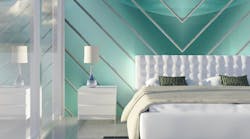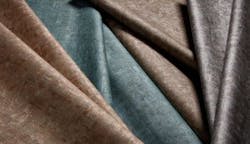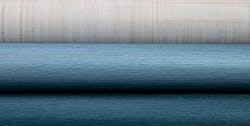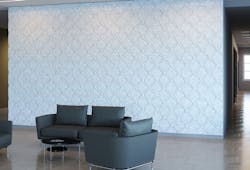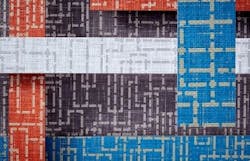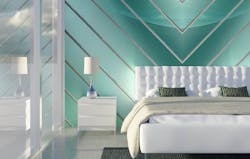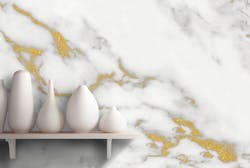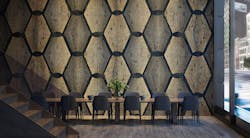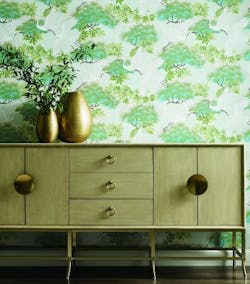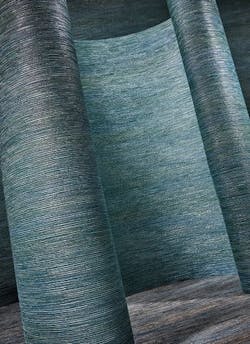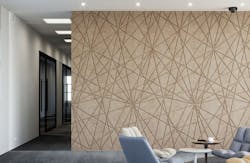4 Criteria to Consider When Specifying Wallcoverings
Wallcoverings are one of the easiest and most cost-effective ways to create design impact in a commercial or residential environment, leveraging the wall to generate visual interest where there once was none. (Photo: Brizio, courtesy of Denovo)
The industry offers a vast array of wallcovering patterns, textures, designs and colorways. Digital printing and specialty materials expand the visual possibilities.
They protect the wall from a host of abuse, while camouflaging drywall imperfections. Though the initial cost for wallcoverings is higher than paint, wallcoverings can last twice as long as paint and require little maintenance, which may make them more economical and efficient in the long run.
New semi-rigid wall protection products offer extreme durability for corridors, public spaces and other high-traffic environments subjected to stains, abrasions and impacts.
According to the Wallcoverings Association, wallcoverings last an average of 5 to 10 years. Wallcoverings can be a sustainable solution because their low maintenance requirement minimizes the use of cleaning chemicals, most are low-VOC and many contain recycled content.
[I Hear Design: How Design Materials Turn Toxic During a Fire]
A suite of sustainability tools are available to allow specifics to select and compare products, including:
- NSF 342 Sustainability Standard
- Sustainability Scorecards
- Environmental Product Declarations
- Health Product Declarations
To select the best product for your project, the Wallcoverings Association recommends evaluating four criteria that maximize design impact and ensure long-term performance:
- Durability
- Aesthetics
- Quality and sustainability
- Installation
1. Durability
To anticipate wallcovering performance, it’s important to look at the:
- Material used
- Rating as a Type I, II or III product, which categorizes the type of duty it can withstand
- Weight
“One of the most common mistakes in specifying wallcovering is basing the decision primarily on the product’s aesthetics,” says Beth Rich, a former Wallcoverings Association president and consultant to Versa Designed Surfaces.
(Photo: Versa Impact, courtesy of Versa Designed Surfaces)
“If it will be installed in a heavy use area such as elevator lobbies and corridors, look at whether it’s rated Type I, II or III. The higher the type, the more durable the product. Also be aware of the cleanability and performance of the selected product. Discuss with your sales rep whether a product is suitable for the space you have in mind.”
Because of advances in engineering and materiality, high performance and beautiful aesthetics aren’t mutually exclusive. Type II and Type III wallcoverings offer a plethora of looks that shield the wall from stains and abrasions.
One of the most exciting advancements in recent years are new semi-rigid wall finishes. These stylish designs look like standard wallcovering but stand up to heavy use; challenging stains; and impacts from rolling traffic such as office chairs, luggage carts, maid carts, wheelchairs and gurneys.
Various levels of wall protection allow specifiers to choose the durability level and price point that best suits their project.
Few interior finishes upgrade the aesthetics of a space as quickly and cost-effectively as wallcovering.
Increasingly, specifiers are turning to wallcoverings to bring warmth and sophistication to the range of commercial and residential environments. (Photo: Toru, courtesy of Colour & Design)
There is an almost limitless selection of styles, patterns, textures and colors.
Depending on the designer’s objective, wallcoverings can serve as art, help brand the space, ground the interior in its geographic locale, contribute to a thematic design or establish the familial comfort of home.
This can be done through:
- Bringing the outdoors in through natural imagery
- Creating drama with iridescent mylar backgrounds
- Adding depth and dimension through sculpted embossings
- Imitating more expensive materials such as leather and wood
- Infusing touchable texture into an otherwise featureless surface.
“Wallcoverings are, dollar for dollar, the most transformative finish in an interior,” states Marybeth Shaw, chief creative officer for Wolf-Gordon. “Whether creating a focal point on a feature wall with a bold, custom digital design, or wrapping all four walls in a pattern, wallcoverings impart character and reinforce the designer’s color palette.”
Photo: Mirari, courtesy of MDC
Digital wallcoverings offer opportunities for design impact and customization, and are offered at various price points. Designers are harnessing digital technology not just to supersize prints but to realistically simulate natural materials such as botanicals, woods and stones, industrial riveted metals and porous concretes, and a wealth of other materials.
In many environments, digital wallcoverings are replacing art. Use on feature walls is growing in commercial and residential markets, including hotels, offices, sports venues, healthcare, retail and educational spaces. The detailed photo realism of this technology projects new levels of depth, dimension, color and texture.
You can specify a design as-is or work with the wallcovering provider’s design studio to concept an image that expresses your signature design vision.
In addition, specialty materials bring one-of-a-kind effects to a project. Glass beads, glass fiber, paper weaves, wood veneers and cork are just a few options that bring an element of the unexpected to the wall.
3. Quality and Sustainability
In a move by the wallcoverings industry to advance its sustainability profile, more than 2,000 wallcovering styles are certified to the NSF 342 Sustainability Standard.
[Related: Demand for Sustainable Materials Must Come from Designers]
This indicator of environmentally preferable products requires certification by both the manufacturer and distributor, making it one of the most comprehensive sustainability standards for interiors products.
Certified wallcoverings are recognized by LEED v4 and are eligible for a Pilot Credit. Certified products also meet exacting quality standards, as NSF requires that wallcoverings pass either the W-101 quality standard for vinyl wallcovering or the W-102 quality standard for non-vinyl wallcovering. (Photo: Twig and Heron, courtesy of York)
“The NSF 342 standard brings transparency and clarity to the sustainability profile of wallcovering products,” says Jeff Rezin, technical director of the Wallcoverings Association and president of Rezin Inc. “NSF 342 evaluates criteria across the product lifecycle, from raw material extraction through manufacturing, distribution, use and end-of-life management. Certification provides specifiers with the highest level of confidence and credibility in an interiors market increasingly awash in green claims.”
[On topic: How Reclaimed Teak Can Offer Versatility to Your Project]
To help specifiers identify specific environmental attributes and bring transparency to sustainability initiatives, the wallcoverings industry also offers Sustainability Scorecards.
These tools accompany NSF certified products and distill sustainability information into specific categories. The scorecards explain how a product rates on criteria including:
- Environmental considerations in design
- Inventory of material inputs
- Minimization of known chemicals of concern
- Conservation of energy, water use, recycling and waste minimization
In addition to NSF certification and scorecards, many wallcovering products offer Environmental Product Declarations. The Wallcoverings Association worked with IGI-The Global Wallcoverings Association to develop five industry-average Environmental Product Declarations.
These are accepted internationally and cover the five most-used constructions of wallcoverings:
1. Vinyl wallcoverings on nonwoven backings
2. Vinyl wallcoverings on cellulose fiber bases
3. Vinyl wallcovering on woven textiles backing
4. Wallcoverings on cellulose fiber base
5. Wallcoverings on nonwoven base
The equivalent of a sustainability “nutrition label,” an Environmental Product Declaration discloses the product’s lifecycle-based environmental impacts from cradle to grave and offers a picture of effects on the atmosphere, water and earth.
The declarations are recognized for contributing credit in LEED v4’s Materials and Resources Credit 2. Health Product Declarations may also be available from wallcovering providers. (Photo: Kirenia, courtesy of Denovo)
This suite of sustainability tools helps specifiers and purchasers assess environmental impacts and attributes over the course of a wallcovering’s lifecycle and facilitates product evaluation using factual data that is objective and transparent.
4. Installation
When ready to install wallcoverings, consider the following for a smooth completion.
Timing
Once an order is placed, most wallcoverings are shipped within two to four weeks, depending on the pattern selected and the size of the project. Wallcovering providers offer such vast selections that most specifiers can find what they need in libraries of existing patterns.
To custom-color or custom-design a pattern, allow enough time for development and approvals. A strike-off or approval sample usually takes 7 to 10 days to generate, and the process may require several strike-offs. Generally speaking, you’ll need a minimum of six weeks to develop a custom design and a minimum of four weeks to custom-color an existing pattern.
[Read also: 5 Tile Trends You Can Expect to See in 2020]
Amount
Your contractor and installer can help calculate how much wallcovering you need, and an estimator is available at wallcoverings.org/HowtoEstimate.
“It’s helpful to have the installer visit the site and do the measuring, as there are strategies that only the installer will think about,” advises Cyndi Green of Cyndi Green’s Wallcovering LLC and a former president of the Wallcovering Installers Association. “When measuring for an accent wall, we’ll ensure the focal point of the design is in the middle of the wall. When working with grasscloth, fabric, linen or a design that panels, we place the seams so that they appear as part of the design and are balanced in the room. We treat each wall individually, so an overall measurement may not provide enough material.”
Digital murals have a different set of strategies, Green adds. “A digital mural is made specifically for an area. We’ll check to see whether there is an air conditioning vent or thermostat that will interrupt the design. Then we’ll shift the material so that an important design element does not fall on that obstruction. This also may generate the need for additional material.”
Wall Quality
Mylar, foil, flat finish or handmade products work best on a flat surface. Sometimes, a liner can be installed to hide imperfections and ensure that seams are consistent.
For less-than-perfect walls, look for wallcoverings with an embossing, surface texture and/or heavy pattern, which will hide wall imperfections and camouflage future abuse. In busy corridors and public spaces, consider Type III wallcoverings and semi-rigid wall protection.
Photo: Zintra, courtesy of MDC
Installation
Installers generally hang three drops and then inspect the wallcovering to ensure there are no problems. If there’s a concern, they should call the wallcovering provider immediately. The general rule is that once a wallcovering has been installed, it can’t be returned.
Veronica Leal, wallcovering instructor for the Chicago Painters Union Apprenticeship Program, advises designers to think about break points or areas where walls transition from one surface material or wallcovering pattern to another.
“One of the biggest issues we have in the field is creating a transition where different wallcoverings or different materials meet,” she says. “You don’t want to see an open corner. On the construction site, the last thing you have is time. So it’s best to plan ahead. There are many ways to finish this detail, so discuss your preferences with the installer.”
Wallcoverings Resources
The Wallcoverings Association has numerous resources to educate and inform.
Industry Sample Book: Includes samples of various wallcoverings materials and backings and suggestions for common applications, developed by the Wallcoverings Association and its members. Available to interior design professionals for $10 each and no charge to design students.
The Well-Covered Wall CEU: Topics include the basic construction of various wallcoverings, features and benefits, project planning, installation and maintenance factors. The CEU is registered with the Interior Design Continuing Education Council (IDCEC), and credit is accepted by ASID, IIDA and IDC.
Resource Center: Technical information, common terms, guidelines and more.
Read next: 10 Trends in Wallcoverings
Experience other How to Specify topics:
